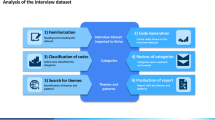Abstract
Fairness in evaluation processes for women in science and engineering is only one of a set of issues that need to be addressed to reach gender equality. This article uses concepts from Amartya Sen’s work on inequality to frame gender issues in science and technology policy. Programs that focus on increasing the number of women in science and engineering careers have not generally addressed a broader set of circumstances that intersect with gender at various economic levels and stages of life. The agendas in research and innovation policies also need to reflect these issues, and fair allocation of resources within both science and technology needs to be on the agenda. Getting women into high-level positions is not enough. Articulating the full research and innovation agendas for women will require broader participatory processes.
Similar content being viewed by others
Notes
S&T-intensive regulatory policies could be considered a fourth area, but are not included here.
This definition of well-being serves as alternative in Sen’s approach to the concept of welfare in utilitarian economics.
The much-discussed processes of cumulative advantage and disadvantage can be seen as repeated applications of those differential rates of conversion, turning small initial gaps into large ones over time.
At my previous institution, in the Northeast, parental leave policies were designed as gender-neutral, to encourage men as well as women to participate in childrearing and thus to undermine the expectation that women would be left alone with this task. At my present institution, however, the program that addresses childrearing responsibilities for faculty focuses on women, thus leaving in place the assumption that men will be able to depend on women to carry out this job.
See for example NSF’s Program for Gender Equity in Science, Technology, Engineering and Mathematics. A retrospective summary report is available at http://www.nsf.gov/pubs/2002/nsf02107/nsf02107.pdf, accessed December 30, 2007.
See examples of such programs in Chapters Three and Four NSF 06-60, New Formulas for America’s Workforce, available at http://www.nsf.gov/publications/pub_summ.jsp?ods_key=nsf0660, accessed December 30, 2007.
See for example a model program in physics at women’s colleges, http://www.coloradocollege.edu/dept/pc/whatworks2004/web%20pages/home.htm, accessed December 30, 2007.
See for Project Enhance on women in chemical business and industry, http://www.education.umd.edu/EDCP/enhance_site/, accessed December 30, 2007.
See for example the Committee on Women in Neuroscience, http://www.sfn.org/index.cfm?pagename=WomeninNeuroscience, accessed December 30, 2007.
NSF’s ADVANCE Program, http://www.nsf.gov/pubs/2007/nsf07582/nsf07582.htm, accessed December 30, 2007.
Studies at NSF have shown that female reviewers are more critical of female applicants than male reviewers are.
See for example FY2004 Report on the NSF Merit Review System, Appendix Table 2, http://www.nsf.gov/nsb/documents/2005/MRreport_2004.pdf, accessed December 30, 2007.
See A Study on the Status of Women Faculty in Science at MIT, http://web.mit.edu/fnl/women/women.pdf, accessed December 30, 2007.
References
ETAN Expert Working Group on Women, Science. (2000). Science policies in the European Union: Promoting excellence through mainstreaming gender equality. Brussels: European Commission.
Sen, A. (1992). Inequality reexamined. Cambridge, MA: Harvard University Press.
Acknowledgements
The author thanks the Women and Science Program of the European Commission for the invitation to develop and present these arguments. The article benefited from conceptual work on the connections between science and technology policies and inequalities done under NSF Grant SES 0096428. All opinions, findings, conclusions or recommendations are those of the author and do not necessarily reflect the views of the National Science Foundation.




